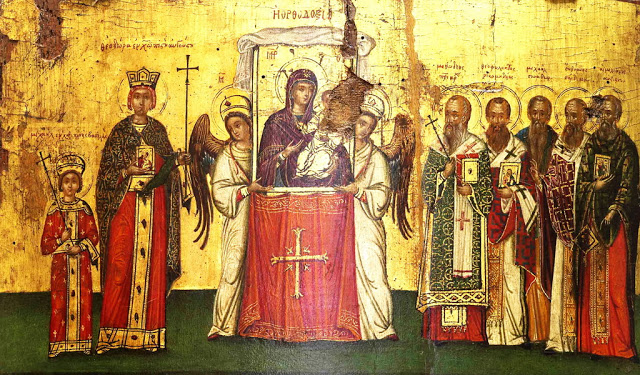
This image got its name after the lines from the following sticheron dedicated to the Mother of God, “Assuage the sickness of my greatly saddened soul, O You who has assuaged the tears of the earth”. Since the 18th century, when the icon became famous for its multiple healings and miracles, it has been called the “Image of the Blessed Virgin Mary Assuaging, which relieves severe wounds and softens men’s hearts”. The people called it the Assuaging Mother of God in short. Many of the copies of this icon also bear the inscription “The image of the Blessed Virgin Mary Alleviation of Sickness” or “Assuage Sickness and Sorrows”. The current name is “Assuage My Sorrows”, although there are also “Allay My Sorrows” or “Assuaged Sorrows”.
In this image, the Mother of God is holding Christ the Child. She supports His feet with her right hand, with her left hand pressed against His cheek. It is as if the Pure One is listening to the words of the Lord Jesus Christ, which one can read on the unfolded scroll, “Judge ye righteous judgment, be merciful and generous to your neighbor; do not wrong the widow and the orphan, and do not do evil to your brothers”.
This icon’s history is associated with Belarus. The first such icon was in Škloŭ, Mahilioŭ Region. It was kept in the Church of the Resurrection and was venerated as a wonderworking icon. Formerly, there had been a convent there, but eventually it was abrogated.
There were copies made of the Škloŭ image. Some copies were brought to Moscow. It happened in the middle of the 17th century, when the Belarusian city was occupied by the troops of Tsar Alexei Mikhailovich. There were two copies in the Russian capital. One copy went to the Church of St. Tikhon of Amathus on the Arbat. The other was in the Church in honor of St. Nicholas in Pupyshi. It was this church that was associated with the following miracle of the Queen of Heaven’s assistance to people.
There was a woman who lived far from Moscow. She was of noble origin and wealthy, but she suffered from a serious illness and was bedridden for many years. No drugs or doctors helped, and the noblewoman had no choice but to rely on the help of God and His Most Pure Mother. Paralyzed, exhausted by many years of attempts to recover, the woman began to pray constantly. As the Church legend says, one day the suffering woman had a dream, in which the Most Pure Virgin, with the Infant in her arms, commanded her to go to Moscow. The Mother of God mentioned the St. Nicholas Church, where the woman was to pray in front of the icon.
As soon as she woke up from her dream, the noblewoman called her servants and gathered her relatives. They harnessed the horses and immediately took the patient to the capital city. However, they could not find that icon that had appeared in the dream among the images in St. Nicholas Church. Suddenly they remembered that there were some images, which had decayed from time, on the belfry. At the request of the local priest, they took the icons downstairs. When the woman saw one of them – the face of the Mother of God covered with dust – she cried out: “That’s her!” …and oh, a miracle! The noble lady started to cross herself. The witnesses of the miracle could not believe their eyes: a few minutes earlier she could not even move her right-hand fingers. A moleben was held before the icon of the Mother of God. As soon as the last hymns were sung, the woman got up on her feet. This wonderful healing happened at the end of the 17th century. History has not preserved the exact year, but it is known that it happened on the 25th of January (Old Style). A special place for the Assuage My Sorrows icon was allocated in the church in 1760. The day of its miraculous discovery was declared an annual celebration. The history of the miraculous recovery of the noblewoman was passed on by word of mouth until 1869.
St. Philaret of Moscow also performed molebens before the wonderworking image. The wives of Russian Emperors Paul I, Nicholas I and Alexander II also prayed before the icon.
When the epidemic of plague broke out in Moscow in 1771, there were many miracles through the prayers in front of the icon. Unfortunately, all the evidence was destroyed in a fire.
In the 1930s, St. Nicholas Church in Pupyshi was destroyed. By God’s Providence the icon has been preserved. It remained in Moscow and moved to St. Nicholas Church near Kuznetskaya Sloboda. It is still there today.
Feast Day: February 7 (January 25 O.S.).
Prepared by Lubov Lutsevich
Translated by The Catalogue of Good Deeds
Source: https://obitel-minsk.ru/chitat/den-za-dnyom/2020/ikona-bozhiej-materi-utoli-moya-pechali



